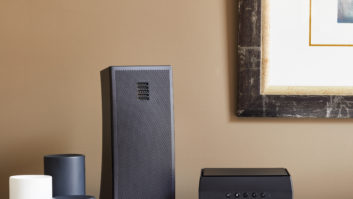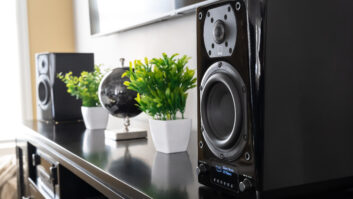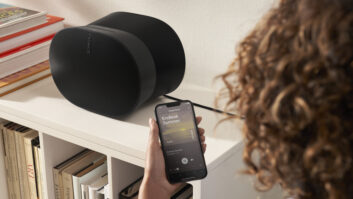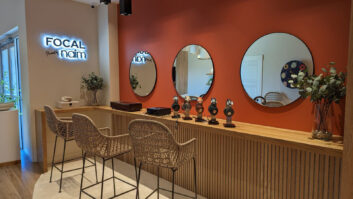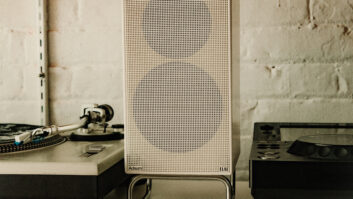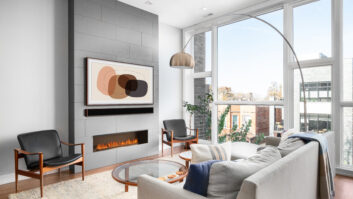Five minutes into unboxing Focal’s Dôme Flax speaker system, I realized I needed an adult, or at the very least a more comprehensible instruction manual. In the absence of both, I soldiered on, poking and prodding and probing these peculiar but gorgeous little speakers until I unraveled their mysteries. Was it worth it? Not to spoil the ending or anything, but it most certainly was. But before we follow that leg of our story any further, perhaps some explanation is in order.
The Focal Dôme Flax is an updated version of the 2010 Resi Award-winning Focal Dôme speaker, which has since been enhanced with a new woofer cone material comprised of flax fiber cores sandwiched between thin layers of glass fiber. As of August, it’s available in two base configurations: Dôme Flax 5.1 ($1,999), which includes five of the Dôme Flax satellite speakers and the company’s ultra-thin and wireless Sub Air subwoofer; and Dôme Flax 5.1.2 ($2,499), including all of the above as well as two of Focal’s ICW-4 in-ceiling speakers, which feature the same driver configuration as the Dôme Flax satellite, with a modified voice coil, speaker surround, and spider. You can also buy the Dôme Flax satellites and ICW-4 in-ceiling speakers à la carte for $399 each, in the event that your client wants to expand to 7.1.4 or what have you.

Focal’s Dôme Flax speaker system
If you’re already familiar with the Dôme or Dôme Flax speakers, there are probably few surprises for you here, but never having laid my front paws on either, I found myself a little perplexed at first. Although the manual for the Sub Air subwoofer is pretty easy to grok, the manual for the Dôme Flax also includes instructions for the company’s Bird, Little Bird, Super Bird, and Sib speakers. And when you factor in all of the languages covered, that doesn’t leave a lot of room for individual attention to each speaker.
So I was left with questions like: Why are there two sets of bottoms for each speaker? (As it turns out, one of them is for wall mounting and the other is for tabletop placement.) And how do I loosen the little screws to insert the speaker cables? (There’s a weensy Allen wrench tucked into the tabletop base of each speaker, as luck would have it. Much like Bowers & Wilkins’ MT series, the connections are actually hidden in the base of each speaker, making cable management a snap.)
The biggest question I had, though, and one that the manual came nowhere close to answering, is this: how in the heck do I aim these speakers without completely HULK SMASHING them? Out of the box, each speaker is pointed directly outward from its base, which is perfect if you plan on wall-mounting them at ear level. But with my front speakers going on the dresser beneath my bedroom TV, I wanted them swiveled 90 degrees, and they didn’t seem to want to turn. Was there a screw to loosen or a release button to press? Nope. It turns out the swivel mechanism simply has a wonderful amount of inertia, meaning that you need to apply firm but steady pressure to start the aiming process (trust me, you’re not going to break the speakers; they’re built like little tanks), and when you get them aimed the way you want, they stay there, barring another firm application of steady pressure.
With the front three speakers aimed properly and the surrounds mounted to the side walls of my bedroom (in this case I skipped the installation of the in-ceilings because of time constraints and the fact that the next hole I cut in my ceiling is probably going to earn me a divorce), I went about the process of calibrating the system with Anthem Room Correction via my MRX 710 AV receiver. A couple of things became immediately clear: Focal’s reported low-frequency extension of 80Hz for the Dôme Flax satellites is only achievable via wall mounting or placement very close to a wall. Without the benefit of such boundary reinforcement, the fronts called for a somewhat higher crossover point of 120Hz or thereabouts. Secondly, the subwoofer placement guide in the Sub Air’s manual isn’t joking: the little sub does sound its best when placed (or hung on the wall via the included mount bracket) as close to a corner as possible.
In the end, I chose to apply EQ to frequencies no higher than 500Hz, because the speakers simply didn’t need any “correction” beyond smoothing out some wobbles in the bass regions and around the crossover point with the sub. In fact, applying room correction above that point would be a legitimate sin, in my opinion, because their response from there on up is as flat and neutral as you could ever hope for in a speaker this size.
Speaking of size, it’s important to remember that for all their complexity and installation-friendly features, these Dôme Flax speakers are small enough to fit in the palm of your hand. And as such, the room I tested them in (roughly 13 by 15 feet) is right on the upper limit of spaces I would try to fill with the Dôme Flax system’s output.
But fill it it does, and with no signs of strain or struggle or distortion that my ears could detect. I threw some of the most action-heavy films I could think of at the system, from Hellboy II: The Golden Army to The Force Awakens (19th viewing, for those keeping score at home), and the worst complaint I could make is that in some of the most boisterous scenes, dialogue intelligibility took a weensy bit of a hit as I pushed the speakers right to the edge of their performance capabilities. But never did the system fail to deliver big, bold, expansive sound. And while the sub was obviously designed more for aesthetic acceptability than outright low-frequency fury, it blended well with the sats and rolled off gracefully at the bottom end, such that the deep bass extension it lacks was easily forgotten and forgiven.
Perhaps the biggest surprise was just how wonderful the system performed with two-channel music, with a lovely soundstage, fantastic neutrality, and great detail. Vocals and acoustic instruments in particular simply shine through the Dôme Flax speakers.
In the end, is this the perfect speaker system? No, but what speaker system is? If you need something compact, though, where style, installation flexibility, and performance are all equally important, I can think of few other compact speaker systems in its class. Pricey? Yes. Worth every penny? Absolutely.
844.362.2562
focal.com
Kudos
When set up properly, the system truly sings, and sounds far larger than it ought to.
Concerns
Physics is physics. The slim subwoofer doesn’t crank out much below 40Hz, and the Dôme Flax really need to be mounted or placed within a few inches of a wall to sound their best.
Product Specs
Dôme Flax
► Type: 2-way compact sealed speaker
► Drivers: 4″ (10cm) Flax mid-bass; 1″ (25mm) Al/Mg inverted dome tweeter ► Frequency response (±3dB): 80Hz – 28kHz
► Low frequency point (-6dB): 72Hz
► Sensitivity (2.83V/1m): 88dB
► Nominal impedance: 8 Ohms
► Minimum impedance: 4 Ohms
► Crossover frequency: 2500Hz
Sub Air
► Type: Flat bass-reflex subwoofer, integrated 150W BASH amp
► Speaker driver: 8″ (21cm)
► Bass cutoff frequency (-6dB): 35Hz
► Frequency response (+/- 3dB): 40Hz-200Hz
► Crossover cutoff frequency variable: 50 Hz – 200 Hz
► Continuous power output: 110 W
► Peak power: 150 W
